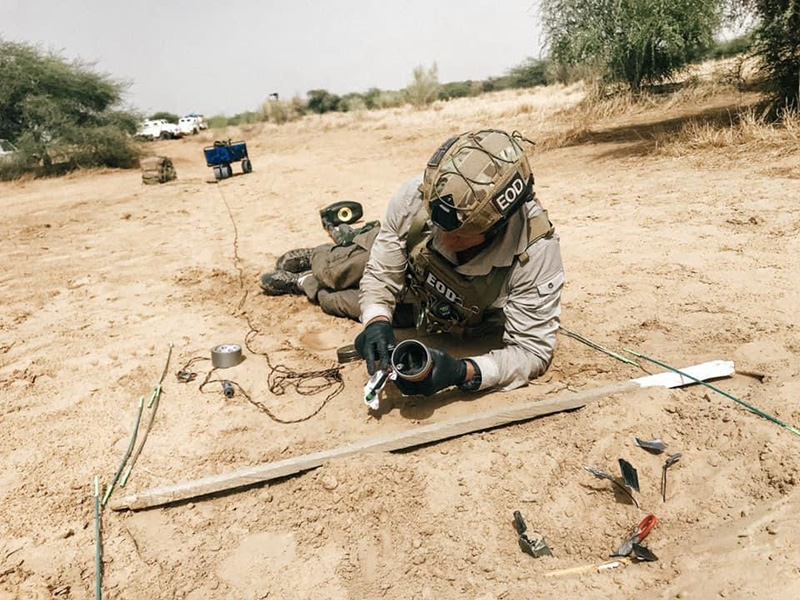Is the disposal of UXO destroying marine environment?
In this subject matter expert opinion piece by SafeLane’s Marine Director Ryan Prophet, he explains how seriously the protection of the fragile marine ecosystem is taken – and what innovations exist to protect from UXO disposal operations.
On Thursday the 22nd of April, SafeLane’s Director of Marine Services, Ryan Prophet, joined actress and campaigner Joanna Lumley on BBC Radio 2’s Jeremy Vine show. They were discussing the disposal of unexploded ordnance in the marine environment, and the detrimental environmental impact so-called high order explosions can have on sea life.
As listeners shared their opinions on the subject matter, it became apparent there is a critical misunderstanding of just how much environmental planning goes ahead of intrusive works offshore, such as the construction of a wind farm or the installation of a pipeline.
To alleviate the justifiable concerns of the public, in this subject matter expert opinion piece by SafeLane’s Ryan Prophet, he explains just how seriously the protection of the fragile marine ecosystem is taken – not only by us, but by our clients as well.
In addition, Ryan details the additional protection measures that can be utilised to protect fish and marine mammals – measures which are a legal requirement off the shores of Europe, but not yet legally required by the British government.
Surveys, studies and consents: the detailed planning processes protecting the marine environment
The potential environmental impact of any offshore, near-shore or inshore construction or infrastructure project is subject to strict governmental scrutiny.
If we take the example of a wind farm off the British coast, there is a rigorous process of consent and approval. Firstly, the sites in question need years of environmental data analysis to start the feasibility process. The Joint Nature Conservation Committee is consulted, environmental impact assessments, feasibility studies and consent surveys are then undertaken, and as all the land belongs to the Crown Estate, permissions must be sought.
Then, when it comes to unexploded ordnance (UXO), according to CIRIA, our industry guidelines, the risk hierarchy is clear – where possible, any munition identified in the marine environment should be avoided.
This means that unless it is absolutely impossible to alter the position of a turbine, or reroute a cable for example, UXO lying on the seabed that is causing no harm to human or marine life is left where it is.
The intimation that the creation of wind farms offshore is resulting in millions of fish and dolphins being killed by the destruction of historic unexploded ordnance is untrue and unnecessarily inflammatory.
Can the disposal of unexploded ordnance under water harm the marine environment?
The (high order) detonation of UXO in the sea can cause harm. However, there are not only less destructive methods of detonation, (e.g., low order deflagration as discussed by Joanna Lumley and as promoted by the campaign she and we support - called Stop Sea Blasts), but there are many additional ways to either avoid the detonation of UXO altogether, or to minimise the impact of any blast.
How to minimise the environmental impact of intrusive marine works
Using real life examples of projects we have undertaken for clients, here are optimum methods of impact reduction.
Before intrusive works are considered there is a large amount of research and analysis done. This starts with a desktop study of the area in question to highlight potential risk factors, from which a non-intrusive survey methodology is built.
Non-intrusive geophysical surveys then allow a more detailed assessment of the marine environment in question, and this can identify any anomalies present that may require further investigation.
There are additional stages of data characterisation possible at this point, these can further reduce the number of anomalies to be surveyed which in turn reduces any impact of intrusive works.
SafeLane has extensive practical experience dealing with all these stages for clients - and with UXO disposal for large infrastructure projects. The main concentration in any disposal works is the safety not only of the personnel involved but of the marine life in the surrounding area.
Working in the Baltic region, SafeLane successfully helped mitigate harm to the environment as well as personnel and plant, the team also developed and utilised a range of additional environmental mitigation techniques including:
- Acoustic deterrents (colloquially known as seal scarers),
- Remote passive acoustic monitors (PAMs),
- Hydrophones to measure peak pressure waves,
- Sonar fish surveys,
- Marine mammal observers,
- Seabed displacement pre and post disposal surveys,
- Turbidity & water quality pre- and post-detonation sampling.
Samples of the seabed and water surrounding the targets were taken to analyse changes pre- and post-any demolitions. This was done as an ongoing monitoring exercise.
How we can all help protect the marine environment from the explosive impact of UXO detonations
We can help raise awareness of the importance of the Stop Sea Blasts campaign, and for those of us who want to do more, we can continue to lobby the government to make the use of acoustic deterrents and bubble curtains a legal requirement for operators in UK waters.
SafeLane will continue to invest in academic study and research development into further techniques and more efficient mitigation methods.
Find out how we can help you


